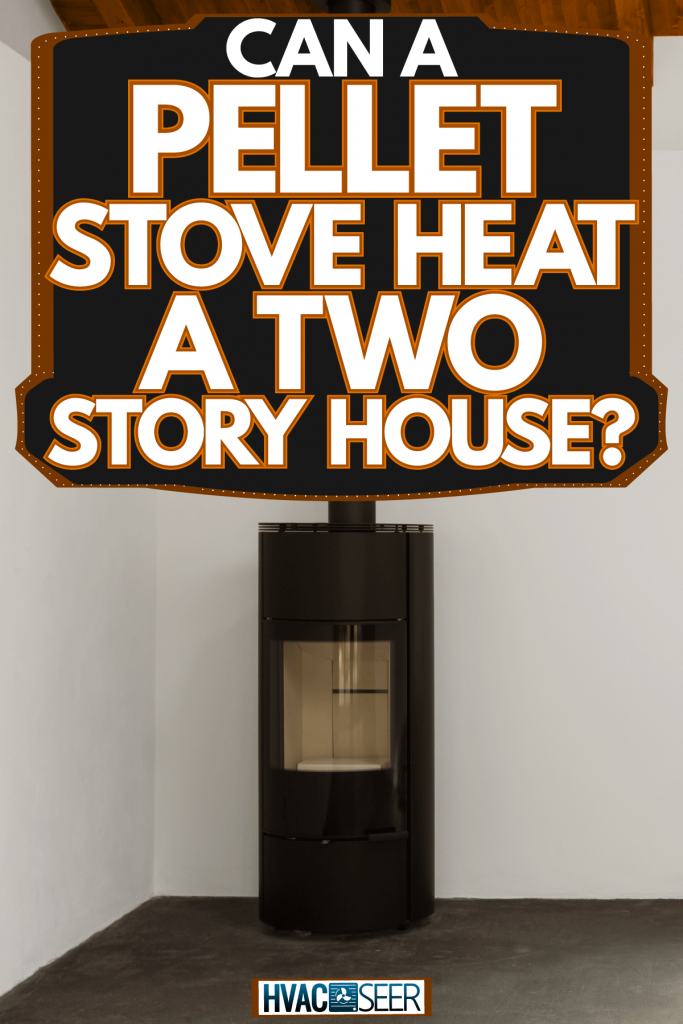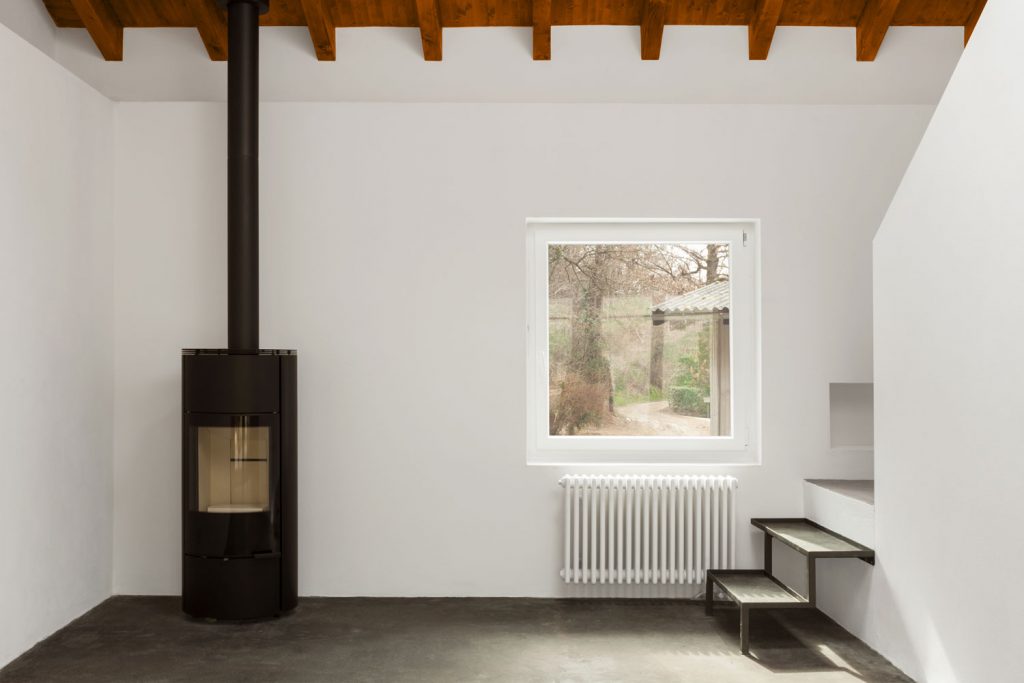Pellet stoves are an excellent heating option for your home. These heaters are more environmentally friendly and economical than many other heating options. If you're considering a pellet stove, you may be wondering how big of a space it can heat and if it's capable of heating a house with multiple stories. We've done the research and can tell you if these types of heaters are capable of doing that!
A pellet stove can heat a two-story home! However, some things can limit its effectiveness. Some things to consider with this heating method are the size of the pellet stove, how it moves air, and your home's size.
Making sure you can heat your whole home is an important task. Let's take a closer look at this subject. Keep reading to learn what size pellet stove you should pick for various square footages, how to circulate heat, and more must-know information!

Heating With A Pellet Stove
Pellet stoves are an affordable and sustainable heating option for your entire home. However, you'll have to ensure that you're selecting the appliance that outputs the correct amount of heat.
If your pellet stove is too small, it won't be able to heat your home. You can also go too big. A pellet stove that is too large for the area wastes energy. It also has difficulty heating areas evenly.
The Department of Energy states that you'll need a 60,000 BTU pellet stove to warm a 2,000-square-foot home. A 42,000 BTU stove will be capable of heating a 1,300-square-foot home.
BTU Needs and Climate
You can use pellet stoves to heat homes in any climate. However, you'll need a pellet stove that has more BTUs if you live in a colder region. While the Department of Energy's recommendation can work, it may not be enough for those in colder climates or homes with lousy insulation.
Here are some ranges of BTU that will potentially work for each square footage:
- 1,000 square feet: 30,000 BTU to 60,000 BTU
- 1,500 square feet: 45,000 BTU to 90,000 BTU
- 2,000 square feet: 60,000 BTU to 120,000 BTU
- 2,500 square feet: 75,000 BTU to 150,000 BTU
Home Layout
Another important aspect is the layout of your home. An open concept house will be able to distribute heat more effectively than a more sectioned-off house.
If you don't have an open concept home, you can still use a pellet furnace as your primary heat source. In these instances, you should look at a pellet stove capable of being hooked up to a duct system.
You can purchase both freestanding and utility pellet stoves or furnaces. A utility pellet furnace should be placed in your basement, outside your home, or in a utility room. These furnaces can be used to heat your water and warm your home.
You can place a freestanding pellet stove anywhere within the home. Freestanding stoves can be integrated into a home's duct system just like a pellet furnace. However, you wouldn't be able to use this type of appliance to heat your water.
How Many Rooms Can A Pellet Stove Heat?
How many rooms a pellet stove can heat can vary greatly. The primary way to tell how many rooms a heater can warm is to determine the square footage of all the rooms.
A pellet stove with at least 60,000 BTUs will be able to heat a home that's 2,000 square feet. The heater will heat all the rooms within that space, which could be as little as five rooms or as many as 12. It all depends on the layout of the house and how well air is circulated.
Method of Distributing Air
There are two different ways that pellet stoves can distribute air. One method your pellet stove will connect directly to a duct system. Air will then flow through the house and heat the individual rooms.
The second method, the pellet stove, pushes air into the room that the appliance is located. These types of pellet stoves have more difficulty heating adjacent rooms. You'll need to be more intentional about where you put this heater.
Where Should A Pellet Stove Be Installed In A House?
Pellet stoves are fantastic because you can incorporate them into the design of your living space. The important thing is that you find a spot that looks good and helps the stove distribute heat.
In homes with multiple stories, you should place the heater either on the lowest level or the story you'll be on the most. A benefit to putting your pellet stove on the bottom level is that heat rises. You can help the heat reach upper levels by installing some floor vents and utilizing fans.
However, keeping your pellet stove on the floor that you'll be on the most can also be effective. This will guarantee that your most lived-in area will be at a comfortable temperature for you.
Here are some additional tips for finding the ideal spot for your heater:
- Choose a large room with multiple doors.
- Consider an area near stairs.
- Keep away from combustible objects like walls and furniture.
How Do I Circulate The Heat From My Pellet Stove?
The easiest way to circulate heat from your pellet stove is by using fans! You can place these tools next to doorway entrances to help push heat into neighboring rooms.
This method is affordable because it doesn't matter what type of fan that you use. The important thing is that you keep them on their lowest setting. If you turn them on too high, you'll be creating and distributing cold air instead of hot.
Don't forget to utilize any ceiling fans! Most of these features can be set to turn clockwise or counterclockwise. Set your ceiling fan to rotate clockwise and then turn it to the lowest power setting.
Another option for circulating air is to install floor air vents. This is most effective when you have your pellet stove on a lower level.
How Long Does It Take A Pellet Stove To Heat A House?
There are a few things that can affect this question. We are already aware of several factors, like the size of the stove, the size of the house, how air is distributed, and the house's layout. Other things also need to be considered for how long it will take the home to warm.
The quality of the house's insulation will play a significant role. If your house has poor insulation or a lot of windows, it will take longer to warm your home. Your heater will also have to work harder to keep it at the intended temperature.
Finally, the desired temperature and efficiency of your heater will affect the time to heat an area. It will take longer to warm a room to 70 degrees Fahrenheit if you start at 50 degrees and not 60 degrees.
With these factors in mind, it can take anywhere from 30 minutes to a few hours to warm your home. Keep in mind that a freestanding pellet stove will quickly heat the room that it's in but will take longer to warm farther rooms.
Is A Pellet Stove A Permanent Heat Source?
A pellet stove can be a permanent heat source, but you have to make sure you're following government guidelines on heating a home. The FHA requires that all livable rooms have a heating source.
This doesn't mean that each room requires its own heater. It means that all livable rooms must receive heat and maintain a temperature of 50 degrees Fahrenheit.
The FHA does specify that wood stoves and solar systems as primary heat sources also require a permanently installed conventional heating system. Please check with a home inspector to determine if your specific pellet stove can be considered a permanent heat source.
In Closing

Pellet stoves are efficient and sustainable sources of heat. These powerful appliances are capable of heating entire homes. When deciding on a pellet stove, be sure to consider where you'll put it and how you'll circulate air around. With two-story houses, you should utilize fans and place your heater on the lowest level to get the most out of your heater.
For more information on pellet stoves, try:
